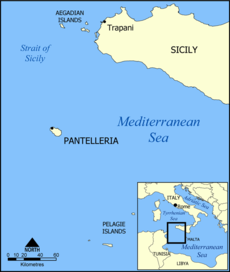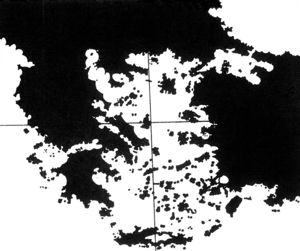obsidian
Schoppe, Christian & Siegfried
Christian & Siegfried Schoppe are a father and son team of German researchers, who firmly assert that Atlantis was located in the Black Sea. More specifically they suggest that Snake Island(b) situated 35 km east of the Danube Delta, was the location of the Atlantean capital. Snake Island has also been referred to in a Russian website(c) that discusses a Black Sea Atlantis. It includes a number of video clips with Russian dialogue.
Snake Island has also been adopted by George K. Weller as the location of Atlantis(h).
Their contention is that before 5500 BC there was a great plain in the northwest of the area, now occupied by the Black Sea, which was then a much smaller freshwater lake. Atlantis in their view was situated on what was formerly the shore of this lake. The Schoppe’s echo the
view of Ryan and Pitman who were probably the first in 1998, to advance the idea that around 5500 BC the barrier at today’s Bosporus broke open due to the rising world sea levels and raised the level of the Black Sea, flooding a huge area of cultivated land, an event that lay behind the story of Noah’s Flood.
The Schoppes, on the other hand, identify this flooding of the Black Sea with the flooding of Atlantis and maintain that the Pillars of Heracles are located at the Strait of Bosporus. They further suggest that the Orichalcum mentioned by Plato was in fact obsidian that used to be a cash-equivalent at that time and was replaced by the spondylus shell around 5500 BC. This geocatastrophic event, according to the Schoppes, led to the Neolithic diaspora in Europe which also began around 5500 BC.>They also claim that included in that movement of refugees from Atlantis were the Vinca people(i).<
They also claim to have identified the location of the ten kingdoms of the Atlantean empire through an investigation of placenames for both meaning and sound. The theories of the Schoppe’s are contained in their book, Atlantis und die Sintflut [186] and outlined on their website(a).
In 2005, the Schoppes offered their theory to the Atlantis Conference on Milos and published their presentation online(g).
In June 2015, Siegfried Schoppe offered the latest paper in support of their Black Sea location for Atlantis(d) for publication on the Atlantipedia.ie website, as well as a shorter note, also in support of their theory(e).
In a short paper(f), the Schoppes also compared the effects of the fall of Rome with the consequences of the demise of Atlantis.
The Atlantis theory of the Schoppes, along with many others matches many of the clues offered by Plato, but for me, I find it difficult to understand how an Atlantis situated east of Athens and north of Egypt in the Black Sea could attack them from the west! In fact, what Plato said was that the invasion came from the Atlantic Sea (pelagos). Although there is some disagreement about the location of this Atlantic Sea, all candidates proposed so far are west of both Athens, Egypt and the Black Sea (Tim.24e & Crit.114c).
>Then, a few years ago the Schoppes suddenly and without explanation ‘closed shop’ and removed all their weblinks!<
(a) https://web.archive.org/web/20190830053312/https://www.black-sea-atlantis.com/black-sea-atlantis/
(b) https://en.wikipedia.org/wiki/Snake_Island_(Black_Sea)
(c) https://survincity.com/2010/04/conspiracy-theory-black-sea-atlantis-the-case-of/ (link broken Dec.2020)
(d) See: Archive 5098 (German)
(e) See: Archive 5099 (English)
(f) See: Archive 2873 (German/English)
(g) https://web.archive.org/web/20190819053202/https://www.black-sea-atlantis.com/milos.pdf
Melos or Milos
 Melos or Milos is the most westerly of the Cyclades in the Aegean Sea. Dr. Galanopoulos was of the opinion that Melos was named after Eumelos the brother of Atlas, the King of Atlantis.
Melos or Milos is the most westerly of the Cyclades in the Aegean Sea. Dr. Galanopoulos was of the opinion that Melos was named after Eumelos the brother of Atlas, the King of Atlantis.
This view led Galanopoulos to conclude that the Pillars of Heracles were therefore located at the western entrance to the Aegean.
Obsidian, a volcanic glass, principally native to Melos, has been found all over the Aegean as well as mainland Greece and has been dated to 13,000 BC implying that that extensive seafaring was possible at that time(a). However, during that period, sea levels were much lower than at present, as the Ice Age glaciations were still in place. This would have led to greater land exposure in the Aegean with shorter distances between islands, which were easily crossed with relatively primitive boats.
A major conference on Atlantis was held on the island in July 2005, entitled The Atlantis Hypothesis: Searching for a Lost Land. At the conclusion of the conference a majority of the attendees supported a 24-point list of criteria that any candidate for the location of Atlantis must satisfy. These are listed under The Atlantis Conference 2005 entry.
(a) https://www.sott.net/articles/show/234192-New-Evidence-Hints-at-Ice-Age-Mariners-in-Ancient-Greece
Pantelleria *
 Pantelleria was formed by ancient volcanic action, but even as recently as 1891 there was a submarine eruption off its NW coast. This ancient vulcanism created large deposits of highly-prized obsidian on the island. Because of its importance for tool making, it was traded extensively in the Central Mediterranean from the Neolithic period onwards(g).
Pantelleria was formed by ancient volcanic action, but even as recently as 1891 there was a submarine eruption off its NW coast. This ancient vulcanism created large deposits of highly-prized obsidian on the island. Because of its importance for tool making, it was traded extensively in the Central Mediterranean from the Neolithic period onwards(g).
The island, formerly known as Cossyra, is an Italian-controlled island between Sicily and Tunisia. One suggestion, from Andis Kaulins has been that it was the original Gaderia(a).
This conclusion is probably based on the existence of a location on the northeast coast of the island called Gadir. However, it must be kept in mind that Gadira or variants of it are frequently found in the Mediterranean region, usually at the site of former Phoenician settlements. However, north of Pantelleria is the Egadi Islands(c), another name evocative of Plato’s Gades.
Gades has been associated with Erytheia in the story of the Trials of Hercules, so if the Map Mistress website is correct in locating Erytheia(d) between Pantelleria and the Egadi Islands, it would confine all the ‘Trials’ in the Central and Eastern Mediterranean, consequently, locating the Pillars of Heracles somewhere in the latter region.
More recently, some authors have identified the Straits of Sicily as being the location of the Pillars of Heracles referred to by Plato in his tale of Atlantis. A land bridge between Sicily and Tunisia, including Pantelleria, has also been suggested, but this is unlikely according to bathymetric data.
Novelist Samuel Butler (1835-1902) identified Pantelleria as Calypso’s Island, but the idea received little support(i).
A fortified Neolithic village has been unearthed on its west coast and ancient structures, known as ‘sesi’, similar to the nuraghi of Sardinia, are to be seen in the southeast. One in particular, known as the Grande Sese, is a 5,000-year-old six-metre high mausoleum, containing twelve ‘cells’. “The civilization who built this and another sese nearby are believed to have settled on the island after arriving from Northern Africa.”(h)
In 2005, jewellery in the style of the Egyptian Second Intermediate Period (1700-1550 BC) was discovered on the island. This would add to the opinion that Pantelleria was a major trading and cultural crossroads in ancient times.
Massimo Rapisarda has commented that “a good candidate to host a primordial civilization might have been the archipelago then existing in the Strait of Sicily, a natural maritime link between Tunisia and Italy, prized by the presence of an obsidian source at Pantelleria.”(f)
In August 2015, it was claimed(b) that a manufactured stone column was found on the Pantelleria Vecchia Bank, just north of the island of Pantelleria, in 40 metres of water. It is claimed that the area was formerly the site of an archipelago, if not actually connected to Sicily before the last Ice Age ended around 7350 BC. The monolith was dated using shells extracted from it. It took no time before the discovery was linked by a number of sites with Plato’s Atlantis. While I believe that the area was part of the Atlantean domain, I am more inclined to date its expansionist intentions to a much later period, such as the 2nd millennium BC.
(a) https://web.archive.org/web/20200130221548/http://www.lexiline.com/lexiline/lexi60.htm
(c) https://web.archive.org/web/20180627052748/http://www.mapmistress.com/egadi-islands-marettimo-levanzo-favignana.html (text only)
(d) https://web.archive.org/web/20180831115550/http://www.mapmistress.com/pantelleria-erytheia-sicily-tunisia.html (text only)
(e) Stone Pages Archaeo News: Ancient Egypt gems on Italian isle (archive.org)*
(f) https://cab.unime.it/journals/index.php/AAPP/article/view/AAPP.932C1
(g) https://www.academia.edu/33910010/Characterization_of_obsidian_sources_in_Pantelleria_Italy
(h) https://www.atlasobscura.com/places/sese-grande
(i) https://www.joh.cam.ac.uk/snap-shots-samuel-butler-esq-1893-94
Aegean Sea
The Aegean Sea is located in the eastern Mediterranean, bounded by the Greek mainland in the north and west, Turkey in the east and extending to Crete in the south. In 1899, R.F. Scharff claimed that it was commonly accepted that the Aegean had been dry land until after the appearance of man(c). Zhirov wrote of this landmass being referred to as ‘Aegeida’ before it subsided to form the Aegean Sea [0458.96], but he doubted that it occurred before ‘thinking man’ arrived there.
 The 15th-century map of Ibn Ben Zara appears to show the islands of Aegean as larger and more numerous than today!
The 15th-century map of Ibn Ben Zara appears to show the islands of Aegean as larger and more numerous than today!
The importance of the Aegean to the ancient Greeks is highlighted by Plato when he described their relationship as one where the Greeks “are like frogs around a pond.” (Phaedo 109a-b)
However, it has been noted(i) that the Homeric poems (and the works attributed to Hesiod) studiously avoid any reference to the Aegean Sea, an avoidance that appears all the more striking when juxtaposed with the fact that there are other named seas in the poems.
A 280-page overview of the Aegean civilisations from the Neolithic to the Hellenistic period(f) is worth a look.
It can be reasonably argued that initially, the Greeks had little knowledge of the world beyond the Aegean, which might explain why Plato did not seem to know the exact identity of the Atlanteans. In this regard, a quote from an AtlantisOnline forum seems relevant – “There is evidence, moreover, that the Greeks were restricted by the Phoenicians to the Aegean Sea for a period of many centuries from 1200 BC onwards, and Naval Historians attribute this to the availability exclusively to the Phoenicians of two elements in ship construction, namely long straight cedar timbers (compared to short sinuous olive timbers available to the Greeks) and Bronze for fixings, claddings and battering rams, which were used in battle to perforate hulls, sinking the enemy.”(e)
Many researchers have suggested the Aegean as a possible location for Atlantis with Thera and Crete as the leading contenders. In fact, it is Thera, with its dramatic volcanic eruption, in the middle of the second millennium BC that still  manages to command considerable support after nearly one hundred years since it was first mooted. Its advocates view it as the most likely source of inspiration for Plato’s tale, in spite of the fact that it conflicts with many of the details described by him.
manages to command considerable support after nearly one hundred years since it was first mooted. Its advocates view it as the most likely source of inspiration for Plato’s tale, in spite of the fact that it conflicts with many of the details described by him.
One regular blogger, ‘mapmistress’, proposed (2010) that the Pillars of Heracles were situated at Rhodes with Atlantis situated north of the island in the Aegean. This suggestion is based on the claim that all English translations of Timaeus 24e are ‘botched’ and that the original does not say “larger than Libya and Asia together” but instead should read “north of Libya and west of Asia”! In fact, she goes further with the claim that the very word ‘Atlantis’ was invented by Benjamin Jowett!(d)
Three Italian linguists, Facchetti, Negri, and Notti, presented a paper to the Atlantis conference on Melos outlining their reasons for supporting an Aegean backdrop to the Atlantis story. Another paper was presented by four members of the Hellenic Centre for Marine Research which demonstrates how three-quarters of the Cyclades Plateau was submerged between 16000 BC and 6000 BC as the sea levels rose after the last Ice Age. Kurt Lambeck and Anthony Purcell also presented a paper along similar lines.
>However, not everyone is happy with Atlantis being placed in the Aegean. About 20 years ago an anonymous contributor to the now-defunct geocities website wrote the following piece regarding the matching of Atlantis with the eruption of Thera(o).
“To arrive at this conclusion is simple enough – take the numbers Plato uses for the dimensions and antiquity of Atlantis, divide them by ten, then keep all the fabulous details about the architecture and pretend it applies to the structures and artifacts recovered by archaeology – then throw out all the details about its conquering armies, its location, and its complete disappearance. No wonder there’s such an exact match!”<
Paulino Zamarro has offered a very radical theory, outlined in his book [024], which claims that Atlantis was located in the Aegean, with its capital on Melos, at a time when sea levels were lower and the islands more extensive in area, with some of them joined together. He postulates an isthmus or land bridge between Gibraltar and Morocco, which he believes was breached around 5500 BC. An idea supported by Strato and Seneca. He contends that this breach not only flooded the Aegean but also was also responsible for the subsequent inundation of the Black Sea, which until then was a smaller freshwater lake.
Diamantis Pastras, a Greek-Australian confectioner presented to the Atlantis Conference in 2005 [0629.295] his theory that Atlantis had been situated in the Aegean Cyclades along with nearby Astipalea in the Dodecanese, which he maintains constituted a single larger landmass 3,500 years ago.
Recent studies have revealed(b) the extent of very early seafaring in the Aegean can be pushed back to around 10,000 BC with evidence of obsidian trading at that period. However, the lower sea level at that time would have meant that the Aegean islands would have been much larger with shorter distances, if any, between them, so it may be unwise to read too much into the obsidian evidence.
A 2018 article pushes back Mediterranean seagoing even further(h). Consider how this evidence may relate to Plato’s comment that when Atlantis was established “at that time neither ships nor sailing were as yet in existence” (Crit.113e). However, December 2022 brought a claim of even earlier seafaring in the Aegean, possibly as far back as 450,000 years ago, according to a team from the University of Patras in Greece led by George Ferentinos(n).
In 1998 William Ryan and Walter Pitman published[025] their evidence for the enlargement of the Black Sea with seawater. The book received widespread attention that led to a subsequent expedition to the area by Robert Ballard, the famous discoverer of the Titanic.
However, Zamarro’s ideas have received very little notice, probably because he has only been published in Spanish. His theory regarding the silting and closure of the mouth of the Mediterranean deserves further consideration, as its confirmation would have a profound effect on the course of future studies of the prehistory of the region and in particular Atlantology.
C.C.M. Hardy was a regular contributor to Sykes‘ Atlantis journal, in which he suggested that remnants of Atlantis would be found in the seas around Greece. Hans-Henning Klein favours the island of Samothrace in the northern Aegean as the home of Atlantis(l).
A half-hearted attempt to link the Greek island of Thasos with Atlantis is to be found on the German de.pluspedia.org website(j).
A recent recruit to the ‘Atlantis in the Aegean’ camp is Christos A, Djonis with his theory[935] that Atlantis lay in the Aegean Sea, to the north of Thera, which itself contained the capital city of the Atlantean confederation. He makes no reference to Zamarro, who proposed a similar location fifteen years ago and consequently, considers Djonis’ work as a form of plagiarism! Apart from that, my gripe is that Djonis wastes over half his book discussing UFOs and ancient astronauts. Another proponent of a Theran Atlantis is Elias Stergakos, who also published his short book[1035] on the Minoan Hypothesis in 2014.
In the same year, the Italian architect Costa Kyrki published a paper entitled Lost Atlantis in which he proposed that the sunken Atlantis was situated between the island of Samos and Miletus on mainland Turkey(k).
J.P. Rambling on his Redefining Atlantis website(g) has now added his support to the concept of an Aegean Atlantis, situated on a large landmass, now mostly submerged, and which included what is now Santorini.
It is worth noting that Jürgen Spanuth In defending his North Sea location for Atlantis scornfully denounced the possibility of an Aegean Atlantis in Atlantis of the North [015.247]. “Neither Thera nor Crete lie in the ‘Atlantic sea’ but in the sea of Crete, which is clearly referred to in Crit.111a and is obviously not the Atlantic sea of Tim.24. Neither island lies at the mouth of a great river; neither was ‘swallowed up by the sea and vanished’ (Tim.25d): the Aegean never became ‘impassable to navigation’ (ibid.) Solon and Plato could never have said of the Aegean that passage there was hindered by ‘impenetrable mud’ (Crit.108e) for both had sailed through it – their contemporaries would have laughed at them if they had made such an absurd assertion.” Spanuth failed to highlight that Plato referred to the shoal of mud in the present tense indicating that it was still a hazard in his day!
What I cannot understand is that if Atlantis had existed in the Aegean, why did Plato not simply say so?
The Atlantisforschung website offers a selection of articles dealing with many aspects of the Aegean and its possible connection with Atlantis(m).
(a) https://atlantipedia.ie/samples/document-250811/
(b)https://www.stonepages.com/news/archives/004698.html
(c) https://www.gutenberg.org/files/33236/33236-h/33236-h.htm#Page_61
(d) https://pseudoastro.wordpress.com/2009/02/01/planet-x-and-2012-the-pole-shift-geographic-spin-axis-explained-and-debunked/ (about half way down page)
(e) https://atlantisonline.smfforfree2.com/index.php?topic=3238.1260
(f) https://www.slideshare.net/darkyla/greeks-9775861
(g) https://redefiningatlantis.blogspot.ie/
(h) https://www.sciencemag.org/news/2018/04/neandertals-stone-age-people-may-have-voyaged-mediterranean
(j) Atlantis Verortung in der Ägäis (Thasos) – PlusPedia
(k) https://www.behance.net/gallery/17045455/LOST-ATLANTIS
(l) ATLANTIS ERAT ! – Es gab ATLANTIS! – Samothrake ist Atlantis – Atlantisforschung.de
(n) Ancient Humans May Have Sailed The Mediterranean 450,000 Years Ago : ScienceAlert
(o) Sunken Civilizations — www.geocities.com/sunkenciv/index.html (archive.org) *
Obsidian
Obsidian is a glassy rock produced as a consequence of rhyolitic volcanic eruptions and is usually dark blue. It was highly prized during the Stone Age when it was found to produce good sharp edges, suitable for tools and weapons when fractured. Michael Grant remarked[661] ”it is the first traded substance of which there are material remains”.
Recent excavations in Northern Israel have revealed the use of obsidian tools over six thousand years ago(e). The nearest source of obsidian was Anatolia, so these pre-Canaanite people must have had trade links that extended at least that far.
It is interesting to read that obsidian was also considered valuable in North America around 7000 BC, when obsidian artifacts were discovered at an underwater site in Lake Huron, using material that had been brought from central Oregon 2,000 miles away(h).
In 2011 it was reported(b) that a new technique, which permitted the dating of obsidian, revealed that the Greek island of Melos saw the mining of obsidian as early as 15,000 years ago and its exportation throughout the Aegean and beyond, which also is evidence of extensive marine travel at that early date. However, 13,000 BC saw sea levels much lower than at present, as the Ice Age glaciation was still in place. This would have led to greater land exposure in the Aegean with shorter distances between islands, which were easily crossed with relatively primitive boats.
Massimo Rapisarda has noted that the only obsidian west of the Aegean in the Mediterranean is to be found in the Central region on the islands of Lipari, Palmarola, Pantelleria and Sardinia(g). A graduate thesis(f) by Barbara A. Vargo, explores in great detail the characteristics, history and distribution of Pantellerian obsidian.
Robert Ishoy who advocates a Sardinian location for Atlantis suggested(a) that obsidian, “commonly used on ancient Sardinia” was the mysterious orichalcum referred to by Plato. On the other hand.  Christian and Siegfried Schoppe, who support a Black Sea location also identify obsidian as orichalcum. This is quite improbable, as obsidian would not easily lend itself to being used as wall cladding. This idea is even more impractical than Jürgen Spanuth’s proposal that orichalcum was a reference to amber. Apart from that orichalcum was described by Plato (Critias 116b-d) as a metal not rock.
Christian and Siegfried Schoppe, who support a Black Sea location also identify obsidian as orichalcum. This is quite improbable, as obsidian would not easily lend itself to being used as wall cladding. This idea is even more impractical than Jürgen Spanuth’s proposal that orichalcum was a reference to amber. Apart from that orichalcum was described by Plato (Critias 116b-d) as a metal not rock.
Dr Ellery Frahm at the University of Sheffield has now developed a method whereby a piece of obsidian can be traced, not only to a particular volcano but to a specific quarry at the volcano(c).
In September 2013, Frahm revealed(d) that a new technique had been developed that permits the sourcing of obsidian artefacts in just 10 seconds.
In 2017 Robert H. Tykot published a very detailed paper on the sourcing and distribution of obsidian in the Central Mediterranean.(i)
Egyptologist Jan Summers Duffy published a short paper in 2021 regarding the use of obsidian in Ancient Egypt(j).
(a) http://www.atlantisdiscovered.org/thesis.htm
(b) Evidence for Earliest Obsidian Trade Found in Aegean – Biblical Archaeology Society (archive.org) *
(f) https://scholarcommons.usf.edu/cgi/viewcontent.cgi?article=2500&context=etd
(g) https://www.maxrap.it/atlantide/atlantisobsidian.htm
(h) https://phys.org/news/2021-06-underwater-site-team-year-old-stone.html
(i) 162 PR Tykot 2017 Open Archaeology.pdf (usf.edu)
(j) (99+) Obsidian in Ancient Egypt- General Academic Letters | Dr. Jan Summers (Duffy) – Academia.edu *



